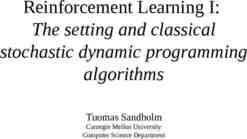Priority Next Steps for Transformation of Health Care Delivery
25 Slides208.77 KB
Priority Next Steps for Transformation of Health Care Delivery System Beyond the Walls of the “H” Rethinking CON and Regulatory Framework PHHPC Strategic Retreat September 7, 2017
6/28/23 2 Session Overview 1. Describe the changing health care landscape to provide context for discussion about alignment between New York’s CON requirements and today’s (and tomorrow’s) systems of care 2. Discuss specific CON-related issues and new models of care. Feedback will guide subsequent in-depth policymaking sessions through PHHPC and the Department’s Regulatory Modernization Initiative (RMI) 3. Purpose is not to kick off development of a new comprehensive CON reform roadmap (PHHPC’s 2012 Report was very prescient and is still quite relevant), but rather focus on specific issues that are: ripe for reform; urgent; and where needed change may be readily attainable within the next year
6/28/23 3 Changing Health Care Delivery System Landscape The major drivers of change are: New payment models—focusing on value and outcomes vs. volume Medical advances—shifting services from inpatient to outpatient IT advances—enabling integration
6/28/23 4 Changing Health Care Delivery System Landscape We see this change reflected in: Increased hospital active parent establishment and mergers (78 approved or currently pending since January 1, 2011) Increased consolidation amongst long-term care providers (175 changes of operators since January 1, 2011) Less inpatient utilization, more outpatient Formation of integrated health care systems centered on ambulatory care Consolidation of inpatient service lines at member hospitals across clinically integrated regional health care systems More care coordinated across providers and levels of care via partnerships and through acquisition More than 30 hospitals that would have closed or significantly reduced services within the past 4 years absent extraordinary state support
6/28/23 5 Changing Health Care Delivery System Landscape Providers are consolidating and partnering in order to: Achieve scale for operating efficiencies—cost increases are outpacing revenue (in large part due to legacy fixed costs and overhead) Achieve scale to be able to succeed in risk-based payment systems Expand community-based ambulatory networks Integrate across levels of care for patient-centered care management in order to better control quality and reduce total cost of care in risk-based payment systems Access financial resources to transform operations and facilities, and to continue to operate during transformation period
6/28/23 6 Changing Health Care Delivery System Landscape This change is important because it is: Necessary to achieve the linked goals of the “Triple Aim” – improving the individual experience of care – improving the health of populations – reducing the per capita costs of care for populations and necessary to ensure the long-term financial sustainability of systems of care
6/28/23 7 Changing Health Care Delivery System Landscape The Department of Health is supporting this change by: Building payment systems that incentivize transformation (DSRIP/VBP) Funding programs and providing technical assistance to expand and enhance primary care and community-based support services, and reduce utilization of emergency department and inpatent services (DSRIP, SHIP, APC) Keeping the existing system from collapsing during transformation phase (VAPAP, VBP-QIP, capital programs), and Modernizing the regulatory system to better align with and foster transformation
6/28/23 8 CON HISTORY 1946—National Hospital Survey and Construction (Hill-Burton) Act 1964—NYS first to enact CON law 1974—National Health Planning and Resources Development Act (NHPRDA) links federal funding to establishment of state CON process 1987—Congress repeals NHPRDA Today—36 states have some form of CON; 14 states have no CON
6/28/23 9 Elements of NYS CON Public Need: Based upon a variety of factors, including population demographics, service utilization patterns, epidemiology of selected diseases and conditions, and access to services Financial Feasibility: Based on expenses, projected revenues, current financial status, capability to fund the project, and ability to repay debt Character & Competence: Based upon experience and past performance in operating a health care service and whether a substantially consistent high level of care was maintained Construction: Facilities must comply with State and federal rules and regulations
6/28/23 10 Purpose of CON 1. Protect the Public Health – Ensure adequate Character & Competence – Ensure facilities meet safety codes and design standards – Ensure minimum volume thresholds for services where there is a relationship between volume and quality – Protect/expand access to essential health care services, particularly for vulnerable populations 2. Control health care costs by constraining unnecessary health care spending – Supply-side management of facilities, beds, expensive equipment and services 3. Ensure institutions do not take on projects that are not financially feasible and could destabilize them To what extent is CON an effective/necessary tool for achieving these purposes in today’s evolving the health care delivery system?
6/28/23 11 CON Discussion Questions Should we look at the Volume Quality proposition differently within a regionally integrated health care network? If so, what is the appropriate context for review? With the move toward care management and risk-/value-based payment systems, should we still be considering the macro health care cost implications of expanding cardiac, radiation oncology, transplant or other CONcovered specialty services within a planning area where projected utilization can be accommodated by existing providers? If expansion of specialty services is permitted in a planning area where projected utilization can be accommodated by existing providers (i.e., there will be winners and losers), what are measures we could take to help ensure preservation/expansion of essential services for economically or geographically vulnerable populations? Should the relocation of inpatient service lines (without change in bed count or category) between member hospitals in a clinically integrated regional network require Department approval? Should financial feasibility reviews be eliminated for projects that are sponsored by providers who are determined by the Department to be financially viable based on defined and pre-established measures? Should PHHPC approval only be required for Establishment CONs and CONs involving change to a service (i.e., eliminated for straight construction projects)?
6/28/23 12 Governance Establishment Models The growth of integrated health care systems is evolving across state boundaries. Systems are becoming national in scope. These national systems provide access to capital resources, expertise in quality, operational efficiency, and financial management Goal: Enable the co-establishment of national provider organizations to improve NYS provider access to capital markets and to standardized systems of operations, finance, and quality. Background: Co-operators of an Article 28 must be fully established and are fully responsible and liable for all establishment powers. Neither statute nor regulation affirmatively requires a co-operator of an Article 28 facility to be responsible for the entirety of 10 NYCRR 405.1(c) establishment powers. There has been a growing development of national models for healthcare systems outside of New York in which a national entity joins with a local health care system to co-operate facilities. This allows local facilities to continue to operate their facilities – and allows the national entity to infuse much needed funds to the facilities. This model does not work in New York State under the Department’s current policy because many national entities do not want to be fully responsible and liable for all of the establishment powers; and such entities do not wish to be a Passive Parent since they would not be allowed to share in the revenues of the facility. For example, a national entity may only want to be responsible for approval of hospital operating and capital budgets.
6/28/23 13 Governance Discussion Questions What new models of establishment could be considered that would give NYS providers the greatest degree of flexibility and choice in choosing affiliation partners to help invest in their facilities and operations and in achieving quality and fiscal sustainability goals? Should DOH/PHHPC allow established co-operators to distribute primary responsibility for specific establishment powers? If so, what should DOH/PHHPC’s roles be in reviewing and approving such distribution? What potential risks exist in such models and how can those risks be mitigated or controlled? How can DOH/PHHPC ensure transparency in the establishment of all ownership models?
6/28/23 14 Governance Character & Competence Goal: promote quality, safety, integrity and financial stability in health care organizations by ensuring that those seeking to operate NYS health care facilities and home health agencies have adequate character & competence to operate them in a responsible manner Background: Current process was created when most operators owned stand-alone facilities / agencies 10-year lookback period Reviews individual owners, board members, shareholders “Taint” threshold: two enforcements for same health/safety noncompliance; timing of enforcements is irrelevant to “taint” decision Enforcement in any related facility creates “taint” to the applicant operator
6/28/23 15 Character & Competence Discussion Questions Does an individual-focused review provide value to determinations of whether the applicant organization, especially a large non-profit health system or publicly-traded organization, is likely to operate a facility or agency in a prudent and safe manner? Does the current “taint” framework make sense with the growth of complex, multi-provider health care systems? If not, how should DOH/PHHPC consider compliance issues in Character & Competence reviews and determinations? Compliance is one aspect of operator performance. Should quality be integrated into the C&C review to better evaluate provider performance? How should that be achieved? How can the performance history of multi-state operating organizations be considered in an efficient but meaningful review? How can the process be streamlined to achieve goals but not unnecessarily delay PHHPC determinations? Should DOH solely carry the burden of review?
6/28/23 16 New Models of Care Integrated Primary Care and Behavioral Health Services Goal: “No wrong door for patients”, particularly patients with chronic physical and behavioral health conditions Background: Currently, integration allowed if meets: Certification Thresholds, Integrated Outpatient Services (IOS) Regulations; DSRIP 3.a.i. waiver Barriers/Concerns: Still three separate sets of licenses, regulations, billing methodologies and oversight for primary care, mental health and substance use disorder (SUD) services Physical plant standards for primary care difficult to achieve for many mental health and SUD clinics Workforce (scope of practice, supervision requirements) Scale to make primary care financially viable IT/medical records infrastructure to make care coordination possible Continuity with Primary Care Provider (PCP)
6/28/23 17 Proposed Integrated Services “Basic” Primary Care Services Primary care services (all ages) including health promotion, family planning services, disease prevention, health maintenance, counseling, patient education, diagnosis and treatment (traditional and/or alternative) of acute and chronic illnesses (optional service) and the utilization of consultation/referral as appropriate. Vaccinations Screenings Diabetes outpatient self-management training (DSMT) services (smoking cessation, other self-management training services) Medical nutrition therapy (MNT) services Diagnostic testing (phlebotomy) Procedures May perform non-invasive procedures normally performed in an outpatient clinic setting. Sedation (no more than local anesthesia may be provided) Health home Medical reconciliation, care coordination, social determinants of health services (housing, educational, etc.) Mental Health Services Required services: (1) initial assessment (including health screening). (2) psychiatric assessment. (3) crisis intervention. (4) injectable psychotropic medication administration (for clinics serving adults), (5) injectable psychotropic medication and administration with monitoring and education (for clinics serving adults); (6) psychotropic medication treatment – clozaril optional under proper supervision/monitoring (7) psychotherapy services (8) family/collateral psychotherapy (9) group psychotherapy; Optional services: (1) developmental testing; (2) psychological testing, including neuropsychological testing?; (3) health physicals; (4) health monitoring; (5) psychiatric consultation; or (6) injectable psychotropic medication administration (for clinics serving only children); (7) injectable psychotropic medication administration with monitoring and education (for clinics serving only children); (8) Peer services. SUD Services Required services: (1) pre-admission assessments (including gambling screening, communicable disease and screening and testing). (2) recommended & required toxicology and testing (HIV/HCV/TB) (3) physical assessment and referral or exam (4) psychiatric assessment. (5) individual and group counselling (6) treatment and recovery planning Optional services: (1) brief intervention (2) brief treatment (3) collateral services (4) complex care coordination (5) outreach (6) peer services; (7) screening (8) medication administration and observation (9)medication assisted treatment (10) intensive outpatient services (11) ancillary withdrawal only with appropriate designation
6/28/23 18 Integrated Primary Care and Behavioral Health Services Discussion Questions Should we allow “basic” Article 28 primary care services to be provided without limitation in Article 31 or 32 settings under OMH and OASAS oversight? Should the physical environment and staffing requirements for such a setting be different than a conventional Article 28 clinic? Should a new “Article 99” integrated clinic type meet higher program standards (e.g., be designated a PCP)? Should this set of basic primary care services be permitted in an Article 28 extension clinic without meeting all current physical environment and program standards?
6/28/23 19 New Models of Care Freestanding Emergency Departments Goal: Provide communities that cannot support a full service hospital with access to acute emergency services Background: Freestanding emergency departments (FED) are a model of care that provides acute emergency services to communities where a full service hospital is not viable. To date, the Department has only approved FEDs that are legacy components of full service hospitals (7 approved). Lenox Hill-Greenwich Village was approved as a hospital division Barriers/Concerns: Lack of board certified emergency services physicians in some rural areas Ensuring that FEDs are needed and not predatory with respect to other hospitals in the community/region Proper coordination of care for patients presenting at FED who require admission and transfer to a hospital
6/28/23 20 New Models of Care Freestanding Emergency Departments HOSPITAL NAME Montefiore Westchester Square Strong West (former Lakeside Memorial Hospital) Adirondack Medical Center / Lake Placid NYU Langone-Cobble Hill South Nassau Emergency Department at Long Beach Tri-Town/A.O. Fox Medical Center Moses Ludington LOCATION (COUNTY) Bronx (Bronx) Brockport (Monroe) Lake Placid (Essex) Brooklyn (Kings) Long Beach (Nassau) Sidney (Delaware) Ticonderoga (Essex) YEAR APPROVED 2013 2014 2014 2014 2015 2017 2017 (in process)
6/28/23 21 Freestanding Emergency Departments Discussion Questions Should DOH establish need standards for the new FEDs that are not legacy components of a former full service hospital? Should new FEDs be required to have co-located primary/urgent care to minimize unnecessary ED visits?
6/28/23 22 New Models of Care Community Paramedicine Issue: Potentially promising model of care but “muddy” regulatory and statutory environment Background: Emerging field where EMTs and paramedics operate outside of their emergency response and transport roles to provide health care services to patients in the community under supervision and direction of a hospital system or other licensed health care provider Model has roots as solution to expanding access to primary care service in rural communities Model is also being applied in context of post-acute care follow-up, monitoring high risk patients with chronic diseases, and as “doctor’s hands” in nursing homes Advances in telehealth technologies are a significant enabler of this model of care Likely to reduce unnecessary emergency department visits and inpatient readmissions Provides secondary income/revenue stream to EMTs and ambulance agencies, so could help address EMT shortages in rural communities Barriers/Concerns: Currently no reimbursement model, so typically implemented with hospital-employed EMTs/paramedics or through contract with health care provider or federal grant funds in support of pilots Lack of clear statutory authorization for EMTs to perform services outside of emergency response role Potential for scope of practice encroachment with other heath care providers, including nurses and home care agencies
6/28/23 23 Community Paramedicine Discussion Questions Is this a model that we should pursue in NYS? What limitations (with respect to convergence with traditional home care services) should be applied to community paramedicine services? What are programmatic strategies for resolving potential “scope of practice” conflicts? What types of patients would benefit most from this service? Is there evidence or outcomes from recent demonstration programs that this approach is effective?
6/28/23 24 New Models of Care Telehealth Issue: Telehealth is widely recognized as an important tool in achieving Triple Aim objectives, but “real world” implementation strategies and the technology are racing ahead of NYS’s regulatory framework. As a result, its potential is not being fully realized Background: DOH, OMH, OASAS and OPWDD have varying and distinct regulations, rules and policies with respect to the use of telehealth DOH reimbursement-focused statute and policies treat telehealth as a service; OMH, OASAS and OPWDD approach telehealth as a tool or modality for providing services The Telehealth Parity Law (PHL 2999-cc and 2999-dd) required commercial insurers and the Medicaid program to provide reimbursement for telehealth services if those services would have been covered if delivered in person In 2016, a total of only 350,000 of Medicaid reimbursement (FFS and MMC) was provided for telehealth services PHL 2905-u allows credentialing by proxy only if the “spoke” or “consulting” site is a hospital Barriers: Statutory limitations on “originating site” (Medicaid) Widely varying standards between commercial plans for reimbursement Credentialing/Privileging Differences across State agencies (modality v service) Keeping PCPs in the loop
6/28/23 25 Telehealth Discussion Questions Given the pace of change, should statute and/or regulations specifically establish service and setting types? Should a patient’s home be an eligible originating site? What can be done to ease the credentialing burden to allow more telehealth sites?






























